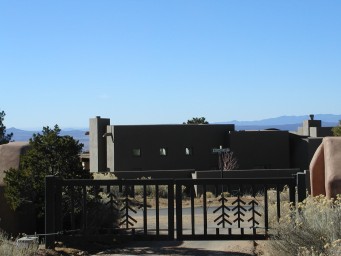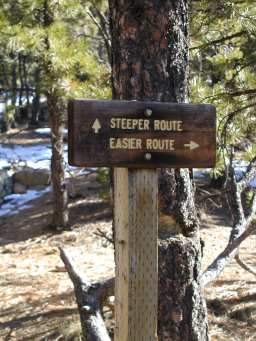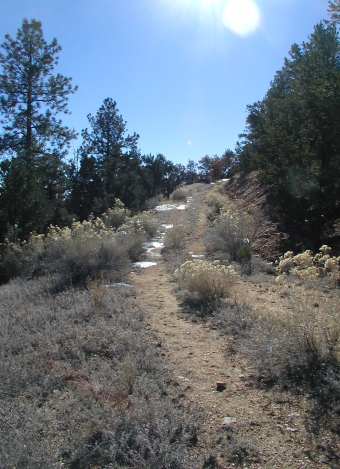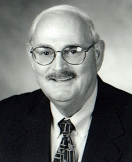The Santa Fe Review


copyright 2004 by George Johnson
Part 1. Rebecca's House and Ludwig's Castle
Part 2. The Chamber of Commerce's (Not So) Secret Candidate
Part 3. David Pfeffer's Letter and Mayor Delgado's Award
Part 4. Tom Mills and the Elusive Qualities of Life
Part 5. The Great Masquerade: Memories of the 2002 Campaign

January 16, 2004
Part 1. Rebecca's House and Ludwig's Castle.
It was too cold and windy on a recent January day for anyone to be hiking to the summit of Atalaya Mountain, but I thought I'd try to make it halfway. I drove up Camino Cruz Blanca and parked at the Wilderness Gate trailhead across from City Councilor Rebecca Wurzburger's imposing new home. (Her old mansion down the road is still for sale.) A visitor to the new place reports that the councilor now has a room with an illuminated, star-bedecked ceiling, modeled after one built by Ludwig II, the Mad King of Bavaria, at his castle at Hohenschwangau. One can gaze at the constellations without having to go outside.

During the year the house was under construction, hikers would notice an odd little sign posted at the head of the driveway: "Rebecca's Home." Like hundreds of others, she had joined the mad rush for building permits that ensued after the 2002 election, when it seemed for a moment that the drought-stricken city might finally have the courage to enact limits on development.
She and her builder friends needn't have worried. Pouring money into her campaign, the most lavishly financed in the city's history, they ensured that it would be business as usual for at least two more years. Rebecca could be counted on to vote their way.
I walked up the road through Ponderosa Ridge (developed by William Parker, who contributed generously to her war chest) and past the stately houses, many of them built, no doubt, on slabs poured by Coppola Concrete, another big Wurzburger contributor.
It wasn't until I had left the roadway and reached the first plateau that I began to feel the exhilaration that comes from being alone on a mountain trail. A few minutes later, I reached a familiar decision point, a junction marked by two signs: "Steeper Route" and "Easier Route." I took the harder one, to the top of the saddle, then began my descent, deciding at the last minute to take a side trip over to Shirley MacLaine Boulevard.

You probably remember the story. One day, about ten and a half years ago, hikers rounding a bend on the trail were startled by the sight of the newly bulldozed scar. To reach MacLaine's 36-acre lot, on a rise halfway up the mountain, a builder, Chapman Homes, bladed the road, outraging so many Santa Feans that ultimately some good came of the project.
With the help of Dale Ball, Stewart Udall, and the Trust for Public Land, a round of inspired wheeling and dealing soon took most of Atalaya out of private hands. But the unpaved boulevard is still there, lined now with Russian thistle and other Eurasian invaders sowed from seeds carried on the tires of the road graders.
I crossed over the roadway and found a trail leading up to Shirley's would-be aerie. What a view she would have commanded, and not just of the blazing stars. Spiritual soul that she is, Ms. MacLaine would have been privileged to gaze out at three of the four sacred mountains of the Tewa Indians: Sandia (or Turtle Mountain) to the south, Chichoma Peak to the west, and San Antonio Mountain up near the Colorado border. She wouldn't have been quite high enough to see over Atalaya to the fourth one, Truchas Peak. Maybe she can see it now from Abiquiu.

In truth Shirley's lookout might not have been quite so bad as her strongest detractors feared. It was hard to take seriously her vow that not a tree would be disturbed -- an impossibility if she planned to erect anything more spacious than a tipi. But properly sited, her new home might have blended unobstrusively into the mountainside.
It was the idea that was so offensive -- "Queen of the Mountain," Udall had called her. Her road became a symbol that things had gone too far.
Today not even Shirley's ghost remains. The only signs of human construction are two large rock cairns -- monuments perhaps to the conservationists' pyrrhic victory -- and a few stones arranged to form a comfortable resting spot for hikers. Her road though will be evident for a century, the bladed dirt eroding in gullies down the mountainside, the Russian thistle crowding out the wildflowers.
So much of what we do is irreversible. From Shirley MacLaine Boulevard, you get a bird's-eye view of the sprawl -- Rancho Viejo, Aldea de Santa Fe, La Tierra, Zocalo, Las Campanas . . . . There seems to be a new development every year and the city or county approves each one. Closer in is the "infill development" that is supposed to be so good for us, as every open space east of St. Francis Drive is subdivided as finely as possible and blotted out by another structure. Through heroic feats of engineering, the developers are even finding more perches for Wilderness Gate homes with the "drop dead views" the realtors enthuse about.
Can anything stop this? With the help of the Mayor, the pro-growth forces continue to dominate the Council. The builders have already hand-picked their man, Rick Berardinelli, to oust Rebecca's nemesis, Karen Heldmeyer, and strengthen their grip.
Having gotten my cardiac workout, in more ways than one, I followed Shirley's driveway back down the mountain, past the opulent homes lower down. One of them, with its earth-tone turrets, might be a Santa Fe architect's take on King Ludwig's castle.

Finally emerging on Wilderness Gate Road I returned to the trailhead. I'd been lucky to find a parking space. There are only eight. A carload of hikers sat idling its engine, waiting for me to leave.
For a moment I thought how nice it would be to grab one of those remaining mountain lots, to build my own dream house with my own private trailhead. If the piñons keep dying and the water table dropping, the price might be right someday.
Postscript, 1/21/04
In today's New Mexican, Councilor Wurzburger is quoted (or actually paraphrased) as saying that the above item uses "a photograph of a house that isn't hers." I believe that the councilor must be referring to this image of the adobe Hohenschwangau that appears toward the end of the piece:

As I hope is clear from the text, this is indeed someone else's residence. (In fact it is currently listed for sale.) Ms. Wurzburger's own home is pictured near the top of the page opposite the Bavarian castle. It is accessed by the driveway where the "Rebecca's Home" sign was posted and was under construction while her building permit was in effect.
The councilor's comment that this journal is part of the Heldmeyer campaign is silly. Readers can easily infer that I intend to vote for the incumbent, and for the first time in my life I have contributed to a political campaign, Karen Heldmeyer's. It feels a little funny -- I'm more comfortable in the detached role of the observer. But so much is at stake this time around.
January 21, 2004
Part 2. The Chamber of Commerce's (Not So) Secret Candidate
The funniest and most revealing quote in the local press so far this year has to be from Jerry Easley, president of the Chamber of Commerce, explaining why his group doesn't endorse candidates for city council. That, he told Tom Sharpe in the New Mexican, is "almost the kiss of death."

"Any time the business community has tried to run their own candidates or get someone out there that represents business, it's been disastrous," he continued. "It just backfires on us."
It is so rare to see such a candid and forthcoming statement that I was sure, when I read the piece, that Mr. Easley must be regretting his choice of words. Then three days later he said the same thing to John Huddy in Journal North.
With its uncompromising message of growth at any cost, the Chamber has long been out of touch with all but a minority of Santa Feans. It's refreshing to know that at least the group's president realizes this.
It was clear enough from both stories that the candidate the Chamber wants elected in District 2 is Rick Berardinelli. And the best way for the group to support him is to not support him. It will be interesting to see if the Santa Fe Area Homebuilders and Realtors Associations take the same approach. There is nothing either group would like more than to have Mr. Berardinelli join Rebecca Wurzburger, Matthew Ortiz, Carol Robertson Lopez, and David Pfeffer in blocking attempts to tie future development to the availability of water.
Of course there is nothing surprising in any of this. In small towns across the country, the local Chamber of Commerce can be counted on as a font of boosterism and babbitry. One might hope that in Santa Fe things would be a little different, that a way would be found to promote a thriving local economy while preserving Santa Fe's biggest selling point -- its ambience and charm.
But a look at the group's agenda -- opposing a higher minimim wage for Santa Fe; lobbying against state legislation to protect "whistle blowers" or to require employers to provide health insurance -- shows that the Chamber mentality in Santa Fe is no different than in Topeka, Tempe, or Sauk Centre, Minnesota.
This is not to say that the Santa Fe Chamber doesn't have a few forward-thinking members, like Joe Hoback, who ran unsuccessfully against Ms. Wurzburger in 2002. His fellow chamberites must have been appalled when, during the campaign, he said that, yes, maybe it would be a good idea to have a moratorium on building new hotels until we have solved the water problem. He realized, I think, that unrestrained growth is not good for the economic prosperity of most business owners, that quality counts for more than quantity.
But once he betrayed his doubts about development, the game was over. His business support quickly retreated and moved to the Wurzburger camp. Not that anyone noticed at the time. Like Mr. Berardinelli, Ms. Wurzburger was the developers' stealth candidate (more on this in a later installment). This time though, thanks to Mr. Easley's timely comment, the cards are on the table.
January 29, 2004
Part 3. David Pfeffer's Letter and Mayor Delgado's Award
Councilor David Pfeffer's most recent letter to the editor of the New Mexican (1/26/04) is a classic illustration of the double-think he has been engaging in since the 2002 election. Defending himself for voting to approve yet another subdivision, during the worst drought in recorded history, the councilor assured readers that the development will not in fact use a drop of new water.
How can this possibly be? "Because the community water budget that forward-looking councilors fought for two summers ago requires that all new construction totally offset its projected water use through toilet retrofits or other water-saving methods."
The other "forward-looking" councilors, of course, are the pro-development bloc of Rebecca Wurzburger, Matthew Ortiz, and Carol Robertson Lopez who (with the tie-breaking vote of Mayor Delgado) forestalled meaningful restrictions on new subdivisions with the legislative shell-game that Fred Rowe aptly dubbed the toilet tax: new construction permits will continue to be issued to one and all so long as the builder agrees to install a certain number of low-flow fixtures in existing homes and businesses.
Mr. Pfeffer's so-called water budget was a political ploy as brilliant as it was meretricious. The Homebuilders Association must still laugh about it today. With city parks and backyard gardens dying all over town, City Hall was under considerable pressure to stop rubber-stamping every construction permit, lot split, and subdivision master plan that came its way. Hence the effort by councilors Chavez, Coss, Heldmeyer, and Bushee to enact an ordinance that would tie new development to the availability of water. Since there is no extra water, that would stop the developers in their tracks.
There were two ways the construction industry could meet this challenge. It could confront it head-on with the usual pro-growth, Chamber of Commerce rhetoric (the "kiss of death," as Jerry Easely now acknowledges), or it could engage in some sophisticated subterfuge: an alternative proposal that would appear, on the surface, to address the water problem but that would in fact result in no limits whatsoever on development.
The result was what opponents called the "nonbudget." As long as a builder pays a couple thousand dollars to replace a few plumbing fixtures, he (or she) can have a permit for more construction. There is no evidence that the number of required retrofits truly saves enough water to make up for the added strain on the system. And Pfeffer and company ensured that building permits already in the pipeline -- a record number -- would be exempted, including the one for Ludwig's Castle. Nor did the ordinance address the rather obvious fact that there is not enough water for the people who already live here. The retrofit requirement was simply a tax -- and a very modest one considering the impact of new development on Santa Fe -- allowing construction to continue unabated.
Some builders still grouse about the requirement. But any doubts that Pfeffer and his allies provided exactly what the industry wanted should be allayed by a small item in today's New Mexican: "Mayor honored by builders group." The story goes on to describe how Mayor Delgado and his wife, Angie, visited Las Vegas, Nevada, earlier this month to accept an award from the National Builders Association -- "to recognize his tie-breaking vote against the [construction] moratorium as well as those of the four councilors who opposed it."
The mayor said he is paying for his wife's expenses. His will be covered by the city budget.
Part 4. Tom Mills and the Elusive Quality of Life
Coming soon: The Great Masquerade, a reminiscence of the 2002 Campaign.
The Santa Fe Review. Please bookmark this site and check back regularly for further installments.
Comments (for possible publication) may be sent to

More links:
Santa Fe water information, a collection of seminal documents and links